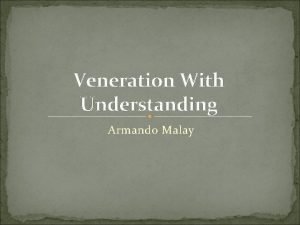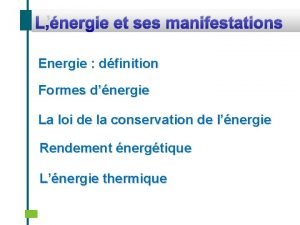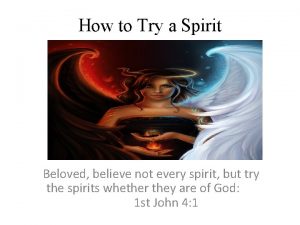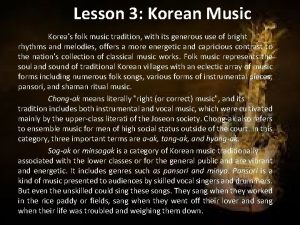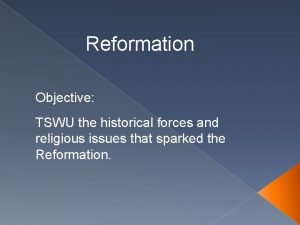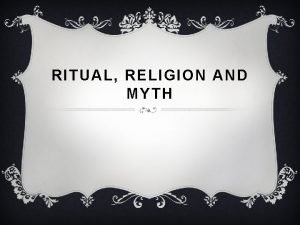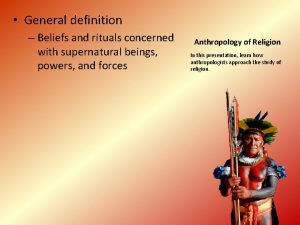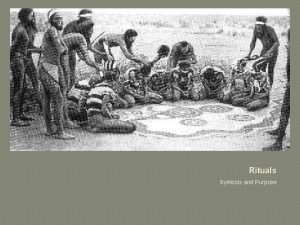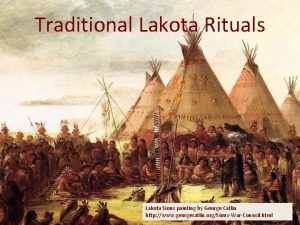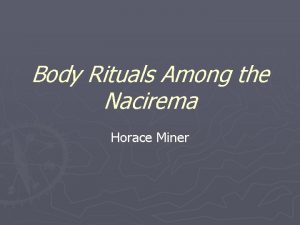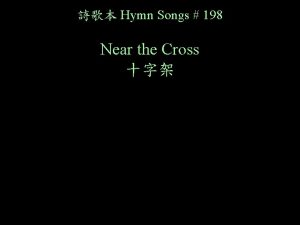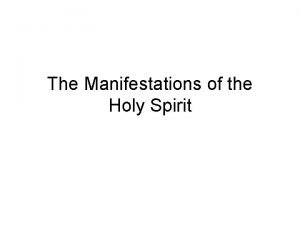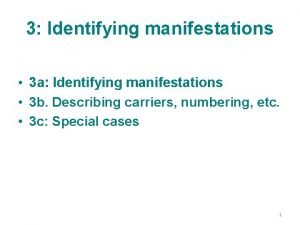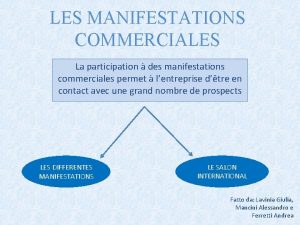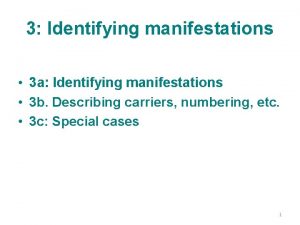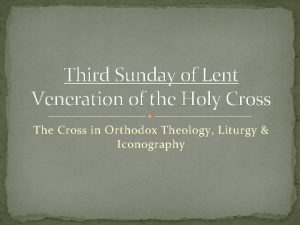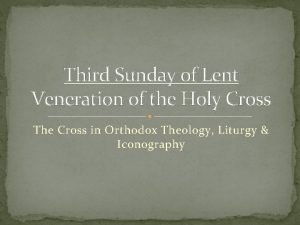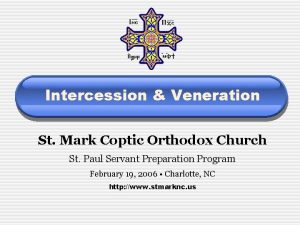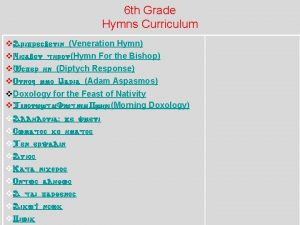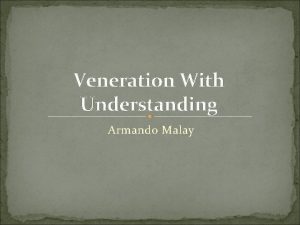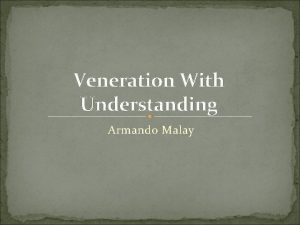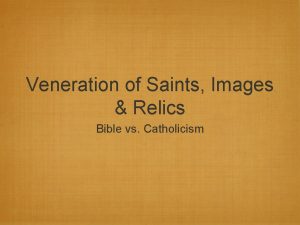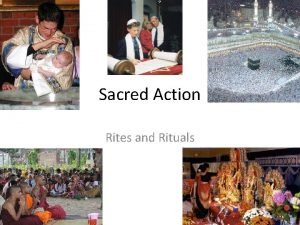Rituals 1 Venerating the Cross Manifestations of veneration













































- Slides: 45

Rituals 1. Venerating the Cross

Manifestations of veneration n We sign ourselves with the sign of the cross before and after prayers. n We sign the food before eating with the sign of the cross. We also use the cross to bless people or clothes. n We rise the cross on our churches. We wear it as a necklace and we hold it in our hands. n We celebrate the feasts of the cross and we use in all the processions in different church’s occasions.

The emphasis of the Lord Christ on the cross n “And he who does not take his cross and follow after Me is not worthy of Me” Matt. 10: 38 n If anyone desires to come after Me, let him deny himself, and take up his cross, and follow Me” Matt. 16: 24 n And whoever does not bear his cross and come after Me can not be My disciple” Lk. 14: 27

The cross was the core of the ministry of the Apostles n “For I determined not to know anything among you except Jesus Christ and Him crucified” 1 Cor. 2: 2 n “…we preach Christ crucified” 1 Cor. 1: 23

The cross was the subject of the Apostles’ glory n “But God forbid that I should glory except in the cross of our Lord Jesus Christ by which the world has been crucified to me, and I to the world” Gal. 6: 14

The cross reminds us with God’s love for us n “ All we like sheep have gone astray; we have turned, everyone, to his own way; and the Lord has laid on Him the iniquity of us all” Is. 53: 6 n “ God demonstrates His own love toward us, in that while we were still sinners, Christ died for us…we were reconciled to God through the death of His Son” Rom. 5: 8, 10

Other meanings (1) n When we make the sign of the cross, we profess that we belong to the Crucified. n Every time we make the sign of the cross, we profess our belief in the Holy Trinity who is the one God forever by saying “In the name of the Father and the Son, and the Holy Trinity, One God. Amen” n Man is not only spirit and mind but he also has senses that should sense the cross through tangible means.

Other meanings (2) n In making the sign of the cross, we profess our belief in the Incarnation and the redemption. We sign the cross from above downward and from left to right to remember that God descended from heaven to earth and transferred us from the left to the right. n Making the sign of the cross is a beneficial religious teaching to the children who might not be able to comprehend all of the spiritual meanings of it.

Other meanings (3) n The sign of the cross gives us power: “For the message of the cross is foolishness to those who are perishing, but to us who are being saved it is the power of God” 1 Cor. 1: 18 n The sign of the cross is the sign of victory over Satan. It fills the children of God with power within, and the enemy trembles without.

Other meanings (4) n All the graces of the New Testament are derived from the cross. That is why the clergymen use the cross in giving the blessing, signifying that the blessing does not come from them but from the Cross of the Lord who entrusted it to them to use in giving the blessing. n The cross reminds us with the perfect obedience and submission shown from the Son towards the Father.

Other meanings (5) n The cross also reminds us with the Lord’ s Second coming: “Then the sign of the Son of Man will appear in heaven, and then all the tribes of the earth will mourn, and they will see the Son of Man coming on the clouds of heaven with power and great glory” Matt. 24: 30

Rituals 2. Facing the East

n Our churches are built facing eastwards. We pray facing toward the East since it direct our hearts to much precious contemplation.

Why the East (1) n Before God created man, He created the East as a source of light to him by creating the sun in the 4 th day. The rising of the sun is a symbol of Christ and His light. The Lord is called the “Sun of Righteousness”, and it is written: “…the Sun of righteousness shall arise with healing in His wings” Mal. 4: 2

Why the East (2) n God planted the Garden of Eden in the East for Adam. It symbolizes the Paradise to which we aspire (Gen. 2: 8) n The Magi saw the Star in the East (Matt. 2: 2). The star was a symbol of Divine guidance; when the Magi followed it, it led them to the Lord.

Why the East (3) n The Lord’s star appeared in the East and His mother the Virgin Mary was likened to a gate facing toward the East (Ez. 44: 1 -2) n In the Book of Ezekiel the Prophet we learn about rivers of life in the east (Ez. 47: 1 -9). And in the Second Book of Kings, it is written that the East is the “arrow of the Lord’s deliverance” 2 Kin. 13: 17.

Why the East (4) n The Holy Bible mentions several times that the glory of God is in the East: “Therefore in the east give glory to the Lord” Is. 24; 15. In the Book of Ezekiel, there is a prophecy about the coming of Christ in His glory from the East: “And Behold, the glory of God of Israel came from the way of the east. His voice was like the sound of many waters; and the earth shone with His glory” Ez. 43: 2

Why the East (5) n Many of theologians say that the Second Coming of the Lord will be from the East: “And in that day His feet will stand on the Mount of Olives, which faces Jerusalem on the east” Zech. 14: 4

Why the East (6) n In the Baptismal Service, in a symbolic way, the baptized and his godparent face eastward to renounce Satan and then eastward to recite the Creed. Thus the baptized feels that he is transferred from west to east, that is, from darkness to light.

Why the East (7) n When we pray we look up although God is everywhere. But looking upwards evokes in our hearts spiritual feelings which give more depth to our prayers. The same applies on facing the East.

Rituals 3. The Sanctuary and the Altar

The presence of the Altar in the New Testament (1) n St. Paul says: “We have an altar from which those who serve the tabernacle have no right to eat” Heb. 13: 10. n St. John Chrysostom comments on this passage saying: “St. Paul turned from the symbolic meaning to the actual one… We now have the authority to partake of the Holy Blood which was the authority of the priest only”

The presence of the Altar in the New Testament (2) n “In that day there will be an altar to the Lord in the midst of the Land of Egypt. Then the Lord will be known to Egypt, and the Egyptians will know the Lord in that day, and will make sacrifice and offering” Is. 19: 19, 21

The presence of the Altar in the New Testament (3) n The word “altar” was mentioned more than once in the Book of Revelation. “The another angel, having a golden censor, came and stood at the altar. And he was given much incense” Rev. 8: 3 n St. John also says: “I saw under the altar the souls of those who had been slain for the word of God and for the testimony which they held” Rev. 6: 9

The presence of the Altar in the New Testament (4) n The altar will continue to exist as long as the words of the Divine Inspiration: “The Body and Blood of the Lord” 1 Cor. 11: 27 remain before us. n As long as there is Blood, then there should be an altar, and by necessity, a sanctuary to contain it.

Rituals 4. Incense

Why do we use Incense in our worship (1) n The Lord said to Moses: “You shall make an altar to burn incense on; you shall make it of acacia wood” Ex. 30: 1 n Also He says: “Aaron shall burn on it sweet incense every morning…. and when Aaron sets up the lamps in the evening, he shall burn it, a perpetual incense before the Lord throughout your generations” Ex. 30: 7, 8 n The incense was considered as a sacrifice in itself, offered on an altar called the altar of incense.

Why do we use Incense in our worship (2) n When the Lord sent the plague on the Israelites, Aaron, upon Moses command, took his censor, put incense in it and burnt it with fire from the altar to intercede for the people before God. When he ran into the midst of the assembly and offered the incense, the plague ceased. The Lord accepted the incense from Aaron as a prayer as thought it was a sacrifice (Numbers 16: 44 -48)

Why do we use Incense in our worship (3) n In the Book of Malachi, there is a prophecy about the continuation of the offering of incense and that it is not limited to the Old Testament “For from the rising of the sun, even to its going down, My name shall be great among the Gentiles; in every place incense shall be offered to My name and a pure offering; for My name shall be great among the nations” Mal. 1: 11

Why do we use Incense in our worship (4) n Using the incense in the church resemble the heaven where incense is mentioned in the Book of Revelation: “and the twentyfour elders fell down before the Lamb, each having a harp, and golden bowls full of incense, which are the prayers of the saints” Rev. 5: 8 n “Then another angel, having a golden censor, came and stood at the altar, and he was given much incense, that he should offer it with the prayers of all the saints upon the golden altar which was before throne” Rev. 8: 3, 4

Why do we use Incense in our worship (5) n The Church is resembled to incense in the Book of the Song of Solomon, in which the Divine inspiration says: “Who is this coming out of the wilderness like pillars of smoke, perfumed with myrrh and frankincense, with all the merchant’s fragrant powders? ” Song 3: 6

Spiritual meanings of incense (1) n Incense has numerous meanings that satisfy the senses and nourish the soul. n The first lesson we learn from the incense is the Lord’s teaching: “…he who loses his life for My sake will find it” Matt. 10: 39 n Offering the self is represented by putting the particle of incense in the fire. The saints were particles of incense put into the Divine censor and were burnt by the love of God.

Spiritual meanings of incense (2) n The second lesson from the incense is its constant ascent. The burning incense rises up, stretches, and never cease to ascend and spread. It is likened to an arrow pointing continually to heaven. n Incense also reminds us of the cloud in which the Lord appeared: “I will appear in the cloud above the mercy seat” Lev. 16: 2

Spiritual meanings of incense (3) n The appearance of the Lord in the cloud is also mentioned in the incidence of guiding the Israelites in the wilderness (Numbers 9: 17), talking to Moses over the mountain (Exodus 24: 15, 16), and consecrating the Temple by Solomon (1 Kings 8: 10 -12)

Rituals 5. Lights and Candles

The lights in the Church (1) n We use candles in our prayers, during reading the Bible, in front of the icons of the saints, on the altar, and in the sanctuary in general. n The church itself is called in the Book of revelation; the golden lampstand. St John saw the Lord Jesus Christ in the midset of seven golden lampstands and the Lord said to him: “…the seven lampstands which you saw are the seven churches” Rev. 1: 20

The lights in the Church (2) n The church resembles heaven because it is the house of God or God’s dwelling place, therefore, it must have light to illuminate it like the stars in heaven. n The lights of the church symbolize the saints, to whom the Lord says: “Let your light so shine before men” Matt. 5: 16

The lights in the Church (3) n The church is lighted after the pattern of the Tabernacle and the Sanctuary. They were full of lights and their lamps were never put out (Exodus 27: 20, 21) n Extinguishing the lamps’ light or negligence in lighting them were considered as treachery to the Lord and deserved punishment (2 Chr. 29: 6 -8)

The lights in the Church (4) n Lights also symbolizes readiness, perpetual watchfulness and preservation of the work of the Holy Spirit in the heart: “Let your waist be girded and your lamps burning…” Lk. 12: 35 n We also find the same meaning in the parable of the ten virgins.

The lights in the Church (5) n Lightening candles during reading the gospel reminds us with the verse that says: “Your word is a lamp to my feet and a light to my path” Ps. 119 n The candles that we light before the saints’ icons remind us that the saints were lights in their generations; melting like candles in order that their light might shine before people.

Rituals 6. Pictures and Icons

Objection to pictures n Those who object the presence of pictures in the church consider them against the second commandment: “You shall not make for yourself any carved image, or any likeness of anything that is in heaven above, or that is in the earth beneath, or that is in the water under the earth. You shall not bow down to them or serve them” Ex. 20: 4, 5

Reply to the objection (1) n God’s aim in banning images and statues was clear in His words: “You shall not bow down to them nor serve them”. Therefore the commandment is not broken if the purpose of using them is far from worship. n God ordered Moses in the incident of the snakes to “Make a fiery serpent, and set it on a pole; and it shall be that everyone who is bitten, when he looks at it, shall live” Num. 21: 8

Reply to the objection (2) n When the Lord ordered Moses to build the Ark of Covenant, He asked him to make tow cherubim of gold on top of it (Exodus 25: 18 -22). n In the same manner, Solomon built the Temple and decorated it from within (1 Kin. 6: 23 -29). Thus the house of the Lord was decorated with images, paintings and carvings and the people still worshipped God.

Reply to the objection (3) n In venerating the icons, we are in effect venerating their owners. When we kiss the Bible, we show our love to the word of God. When we bow before the cross, we worship Him who is crucified on it. n We cannot disregard the effect of pictures as lessons explaining the events of the Holy Bible and the Lives of the heroes of faith. An icon may leave a more profound effect on the soul than reading or listening to a sermon.
 Venerated quarrel
Venerated quarrel Low t3 levels
Low t3 levels Hypercalcemia nephrogenic di
Hypercalcemia nephrogenic di Extra articular manifestations of rheumatoid arthritis
Extra articular manifestations of rheumatoid arthritis Ocular sign
Ocular sign Chapitre 3 l'énergie et ses manifestations
Chapitre 3 l'énergie et ses manifestations Spirit of jealousy manifestations
Spirit of jealousy manifestations Folk songs religious works court music and shaman rituals
Folk songs religious works court music and shaman rituals Lutheranism beliefs
Lutheranism beliefs Görücülük
Görücülük Prescriptive ritual
Prescriptive ritual Macro cosmos psychology
Macro cosmos psychology Taoist practices and rituals
Taoist practices and rituals Example of a ritual
Example of a ritual Supernatural rituals
Supernatural rituals Rituals symbol
Rituals symbol Ritual kinship
Ritual kinship Type of rituals
Type of rituals Shamanism hmong
Shamanism hmong Classification of rituals
Classification of rituals Sweat lodges
Sweat lodges Shrine box/chest definition
Shrine box/chest definition In the cross, in the cross be my glory ever
In the cross, in the cross be my glory ever Test cross and back cross with example
Test cross and back cross with example Condylar guidance and incisal guidance
Condylar guidance and incisal guidance Types of dominance genetics
Types of dominance genetics What is the difference between phenotype and genotype
What is the difference between phenotype and genotype Test cross and back cross
Test cross and back cross Fecboak
Fecboak Một số thể thơ truyền thống
Một số thể thơ truyền thống Các châu lục và đại dương trên thế giới
Các châu lục và đại dương trên thế giới Thế nào là hệ số cao nhất
Thế nào là hệ số cao nhất Sơ đồ cơ thể người
Sơ đồ cơ thể người Số nguyên tố là
Số nguyên tố là Tư thế ngồi viết
Tư thế ngồi viết đặc điểm cơ thể của người tối cổ
đặc điểm cơ thể của người tối cổ Mật thư anh em như thể tay chân
Mật thư anh em như thể tay chân Thang điểm glasgow
Thang điểm glasgow ưu thế lai là gì
ưu thế lai là gì Thẻ vin
Thẻ vin Bàn tay mà dây bẩn
Bàn tay mà dây bẩn Thơ thất ngôn tứ tuyệt đường luật
Thơ thất ngôn tứ tuyệt đường luật Các châu lục và đại dương trên thế giới
Các châu lục và đại dương trên thế giới Từ ngữ thể hiện lòng nhân hậu
Từ ngữ thể hiện lòng nhân hậu Bổ thể
Bổ thể Tư thế ngồi viết
Tư thế ngồi viết
